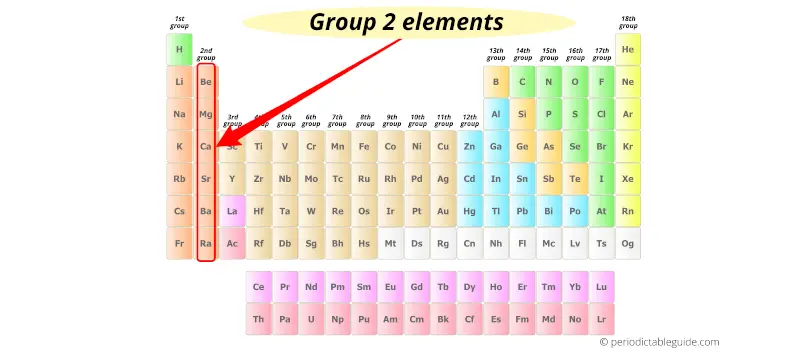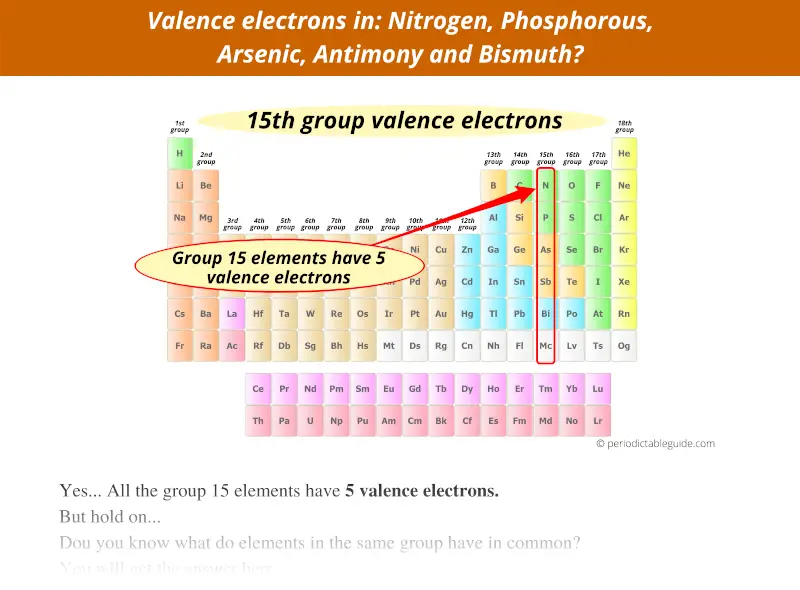The elements in the same group have 2 things in common.
- Common valence electrons and
- Common properties

For example;
Example #1
Let us consider group 1 elements.

All the elements of 1st group (H, Li, Na, K, Rb, Cs, Fr) have one valence electron.
In other words, these elements have only one electron in their outermost orbit.

Also, the elements lying in the same group have common properties.
For example,
Group 1 elements (lithium, sodium, potassium, rubidium, cesium and francium) have similar physical properties like, metallic luster, softness, etc.
Also they have similar chemical properties. For example, all the alkali metals (group 1 elements) are highly reactive to water.

Thus all the elements of group 1 have the same number of valence electrons (i.e 1) and also they have similar physical and chemical properties.
Example #2
Now let’s see what do elements in group 2 have in common?

These are the group 2 elements
All the group 2 elements have 2 valence electrons (or 2 electrons in outermost orbit).

Plus, these group 2 elements also show similar physical and chemical properties.
Thus all the elements of group 2 have same number of valence electrons (i.e 2) and also they have common properties.
Similarly,
Example #3
All the elements of 13th group have 3 electrons in its outermost orbit.

They also show similar properties like good electrical conductivity, higher melting and boiling point, similar chemical reactivity, etc.
Thus all the elements of group 13 have same number of valence electrons (i.e 3) and they have similar properties.
Example #4
All the elements of 14th group have 4 electrons in its outermost orbit.

They form oxides of the type MO and MO2 (like CO, CO2, SiO2, PbO2, etc).
Hence, all the elements of group 14 have the same number of valence electrons (i.e 4) and they have common properties.
Example #5
All the elements of 15th group have 5 electrons in its outermost orbit.

And they have similar chemical properties.
Example #6
All the elements of 16th group have 6 electrons in its outermost orbit.

These elements are found in their polyatomic state, they have similar outer electron configuration ns2 np3, and few other similar properties.
Thus, all the elements of group 16 have the same number of valence electrons (i.e 6) and they show common properties.
Example #7
All the elements of 17th group have 7 electrons in its outermost orbit.

Elements of group 17 are highly electronegative and have higher ionisation enthalpy. They react with water and form halides.
Thus all the elements of group 17 have the same number of valence electrons (i.e 7) and they show common properties.
Example #8
All the elements of 18th group have 8 electrons in its outermost orbit.

All the elements of the 18th group have completely filled valence electrons and they are chemically inert. These elements are also known as Noble gases.
Hence they have the same number of valence electrons plus they show similar properties.
(Note: 13th group elements have 3 electrons in outer shell, not 13.
14th group elements have 4 electrons in outer shell, not 14.
15th group elements have 5 electrons in outer shell, not 15.
16th group elements have 6 electrons in outer shell, not 16.
17th group elements have 7 electrons in outer shell, not 17.
18th group elements have 8 electrons in outer shell, not 18.)
Exceptions
Elements of d-block and f-block have some exceptions. These elements do not show the same number of outermost electrons as that of their group number.
For example, 3rd group elements should have 3 valence electrons, but they have only 2 valence electrons.
Similarly, 4th group elements should have 4 valence electrons, but they also have 2 valence electrons.
Even some d-block elements have 1 electron in their outermost orbit.
This is because the d-block elements have outermost electrons in s-orbitals as well as d-orbitals. (If you do not know about orbitals, visit here)
Also these d-block elements have incomplete d-orbitals.
Thus electrons of both s-orbitals as well as d-orbitals participate in chemical reaction.
Similarly, f-block elements have incomplete f-orbitals.
And here also, the electrons of both s-orbitals and f-orbitals participate in chemical reaction.
Hence d-block and f-block elements have variable valency or different valence electrons other than the group number.)
Also visit: What do periods on the periodic table represents?
Final words
Modern periodic table consist of groups and periods.
The vertical columns are called groups.
The elements which are in the same groups have the same number of valence electrons (i.e same number of electrons in the outermost shell).
Also they possess almost similar properties.
Yes there are also few exceptions in the elements of d-block and f-block.
But in general, for the main group elements (s-block and p-block), the elements of same group have the same valence electrons and common properties.
I hope you have clearly understood what elements in the same group have in common.
If you have any doubts, feel free to ask me in the comments below.
Also let me know, has this article helped you or not?
Explore our New Interactive Periodic Table (with Rotating Bohr Models and More)

Details about this Periodic table:
- Access detailed info on all elements: atomic mass, electron configurations, charges, and more.
- View rotating Bohr models for all 118 elements.
- Get a free HD image of the Periodic Table.
Note: For future use, bookmark this Periodic table or visit “PeriodicTableGuide.com”
Suggested Important topics for you:
- Periodic table of elements (Detailed guide + HD image)
- How are the elements arranged in the modern periodic table?
- Types of metals on Periodic table
- List of elements of Periodic table
- Metals on the periodic table
- Modern periodic table with atomic mass and atomic number
- Detailed Periodic table with electron configuration
- Periodic table with electron shells
- Trends in periodic table
